#ferrari #812 #competizione #aperta Ausverkauft. 999 Einheiten des heute vorgestellten Ferrari 812 Competizione Coupé und 599 seiner Spider-Version Aperta werden produziert. Aber sind bereits von den Ferrari-Kunden absorbiert, die ihre Autos im Voraus bestellt haben, vielleicht wollten sie einen der letzten V12-Ferrari mit Saugmotor besitzen, was von Ferrari nicht bestätigt wird. Wir werden sehen. For english copy scroll down please.
Die Präsentation fand an einem ganz besonderen Ort statt,der kürzlich eröffneten GT-Sport-Abteilung direkt neben der Rennstrecke in Fiorano, welche die untrennbare Verbindung zwischen den Straßensportwagen aus Maranello und der in über 70 Jahren aus Erfolgen auf den Rennstrecken dieser Welt geformten Rennsport-DNA weiter vertiefen soll. Zu Beginn der Präsentation drehte der 812 Competizione mehrere Runden auf der Rennstrecke, um den Zuschauern die Formen des Autos in diesem dynamischen und performanten Umfeld zu zeigen und natürlich,um den unverwechselbaren Klang von Ferraris legendärem V12-Saugmotor hören zu lassen. Nach diesen Overtüre Runden stellte Enrico Galliera, Chief Marketing & Commercial Officer von Ferrari, das Auto offiziell vor und präsentierte anschließend den 812 Competizione Aperta.
Erstärktes Herz und innovative Hinterachslenkung

830 PS als Leistung dank der Neugestaltung vieler Schlüsselkomponenten des Motors, einer neuen Ventilsteuerung und einer neuen Abgasanlage erhöhen die Leistung des V 12 und erhöhen die Drehzahlgrenze auf 9.500 U / min.Mit einem 7-Gang-Doppelkupplungsgetriebe ausgestattet, werden durch die Kalibrierung der Regelstrategien die Schaltzeiten um weitere 5 Prozent reduziert. Obwohl die gleiche Übersetzung wie beim 812 Superfast bei behalten wurde, sind die Schaltvorgänge dank der zusätzlichen 500 Umdrehungen pro Minute bei der erhöhter maximaler Drehzahl des neuen V12 noch schneller.
Überarbeitete Steuerungssysteme für die Fahrdynamik, einschließlich der Side Slip Control (SSC) Version 7.0 und der Hinterradlenkung, die zum ersten Mal unabhängig voneinander verschiedenen Winkelstellungen der Hinterräder ausführen kann, vermitteln dem Fahrer das Gefühl, als würde sich die Competizione sich auf die Außenreifen stützen und steigern fühlbar die Agilität und Fahrdynamik.
Im Detail stellt der 812 Competizione viele innovative Komponenten vor, die sichergestellt haben, dass er seine Leistungsvorgaben für die Fahrzeugdynamik erreicht. Dazu gehören, die schon erwähnte Verwendung einer unabhängigen Allradlenkung, die Weiterentwicklung des Side Slip Control (SSC) -Systems auf Version 7.0 und die Entwicklung der speziellen neuen Michelin Cup2R-Reifen.


Die unabhängige Hinterradlenkung verfügt über ein neues elektronisches Managementsystem, mit dem der rechte und der linke Hinterrad einzeln und nicht synchron betätigt werden können. Diese Entwicklung führt zu einer signifikanten Verbesserung in Bezug auf die Kontrolle der von den einzelnen Aktuatoren angeforderten Position und zu schnelleren Reaktionszeiten.
Das System unterstützt dabei die Reaktion der Vorderachse auf Lenkradbefehle, behält das Gripgefühl der Hinterachse bei, die sofort auf die Lenkwinkel an der Vorderseite reagiert.
Die neue Lösung hat zur Entwicklung des SSC-Systems geführt, das alle eigens entwickelten Steuerungssysteme zusammenführt und eine gemeinsame dynamische Steuerungssprache verwendet, um die Aktionen aller Systeme zur Verbesserung der Effizienz zu integrieren. Die Side Slip Control 7.0 umfasst das elektronische Differential (E-Diff 3.0), die Traktionskontrolle (F1-Trac), die magnetorheologische Federungskontrolle SCM-Frs und die Bremsdruckkontrolle beim Fahren auf der in Race und CT-Off Manettino verfügbaren Grenze (FDE) Einstellungen und der Virtual Short Wheelbase 3.0, der die elektrische Vorderradlenkung mit der elektronisch gesteuerten unabhängigen Hinterradlenkung integriert.
Wie immer steckt der Teufel im Detail.
Durch den vermehrten Einsatz von Carbon-Komponenten in der Karosserie und im Innenraum konnte das Gesamtgewicht des neuen Ferrari-Bolids um 38 Kilo reduziert werden. Aerodynamische Veränderungen in der Karosserie, insbesondere der Ersatz der Glasheckscheibe des 812 Superfast durch eine Aluminiumabdeckung, die zusätzlich die Aerodynamik mit sogenannten Vortex-Generatoren optimiert, die aus dem Rennsport stammen. So produziert der 812 Competizione 80 Kilo mehr Abtrieb bei 200 km / h als der 812 Superfast.
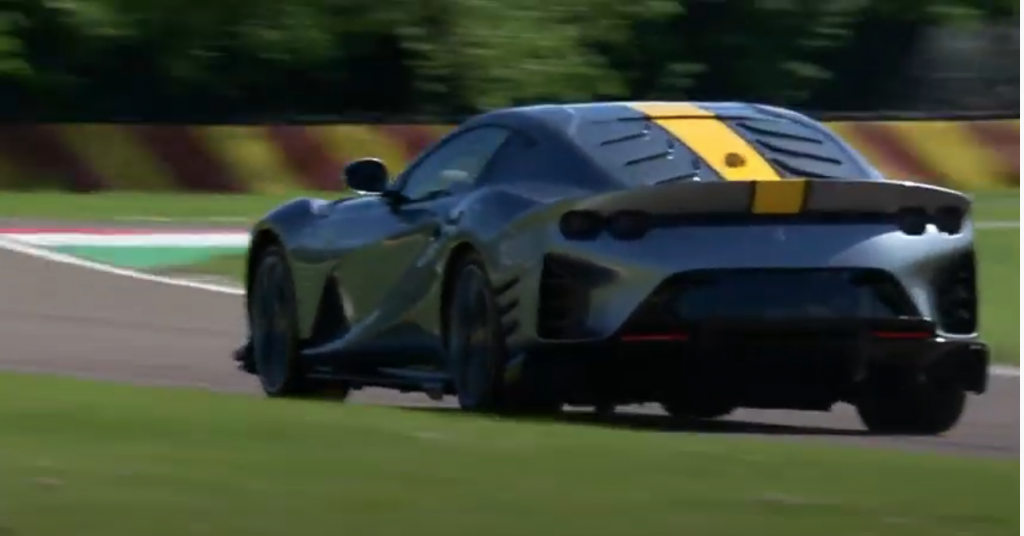
Aerodynamik und Kühlströmungsmanagement
Die Erhöhung sowohl der Motorleistung des 812 Competizione als auch der maximalen Drehzahl hat zu einer konsequenten Erhöhung der Wärmeableitung geführt. Um diesen neuen Anforderungen gerecht zu werden, wurde die Effizienz des Kühlströmungsmanagements verbessert, ohne die Abmessungen und das Gewicht zu erhöhen.
Während beim 812 Superfast die Motorlufteinlässe zu beiden Seiten des großen zentralen Kühlergrills angeordnet sind, verwendet der 812 Competizione eine integrierte Lösung mit einem einzigen Luftkanal. Dies ermöglichte es, den Einlass für die Motorkühler so weit wie möglich seitlich zu verlängern und nicht nur das Gewicht, sondern auch die Verluste an der Ansaugkammer und damit am Brennraum zu reduzieren, was wiederum die Gesamtleistung verbesserte.
Die Evakuierung der aus dem Kühler austretenden heißen Luft wurde verbessert, indem sowohl die Lüftungsschlitze an der Motorhaube auf beiden Seiten der zentralen „Klinge“ als auch die Luftschlitze in den Flügeln ausgenutzt wurden. Diese Bereiche sind in Bezug auf die Kühlung besonders effizient und ermöglichten es den Konstrukteuren, die Öffnungen am Unterboden zu optimieren und zu reduzieren, um die Effizienz des Front-Aero zu verbessern.

Auch das Kühlsystem wurde angepasst, um mit der durch die zusätzlichen 30 PS des neuen Motors erhöhtenWärmeentwicklung Herr zu werden, wurdez um allerersten Mal bei einem Ferrari V12 ein einzelner vorderer Lufteinlass vorgesehen, der die Menge der zu den Kühlern geleiteten Kühlluft maximiert. Der gesamte Kühlmittelkreislauf wurde verbessert, wodurch die Kühleffizienz im Vergleich zum 812 Superfast um 10 Prozent gesteigert werden konnte. Darüber hinaus wurde der einzelne Lufteinlass weiter optimiert, um die Strömungsdynamik des Motoransaugkrümmers zu verbessern und so die Füllungsverluste entlang des Trakts zu minimieren.Und schließlich wurde der Motoröltank neu konstruiert, um den zusätzlichen Durchfluss (30 Prozent mehr) zu bewältigen und die höhere Quer-und Längsbeschleunigung des Autos zu bewältigen. Dank der Optimierung der Innenkammern und -volumen spart der neue Tank im Vergleich zum 812 Superfast über einen Liter Öl, was den 812 Competizione und 812 Competizione Aperta zu den Fahrzeugen mit dem geringsten Ölbedarf in der aktuellen V12-Palette macht. Dies trägt letztlich auch zur Reduzierung des Gesamtleergewichts des Autos bei.
All dies führt zu einer um 10 Prozent effizienteren Kühlung der Motorflüssigkeiten als beim 812 Superfast.
Die Form der Motorentlüftungsöffnungen auf beiden Seiten des Motorhaubenblatts gewährleistet eine korrekte Steuerung der Strömungen, selbst wenn die 812 Competizione A in offener Konfiguration gefahren wird: Die Heißluftströmungen werden vom Cockpit weg- und an den Flanken entlang geleitet, bis sie schließlich mit dem Hauptluftstrom des Autos wieder zusammen geführt werden.
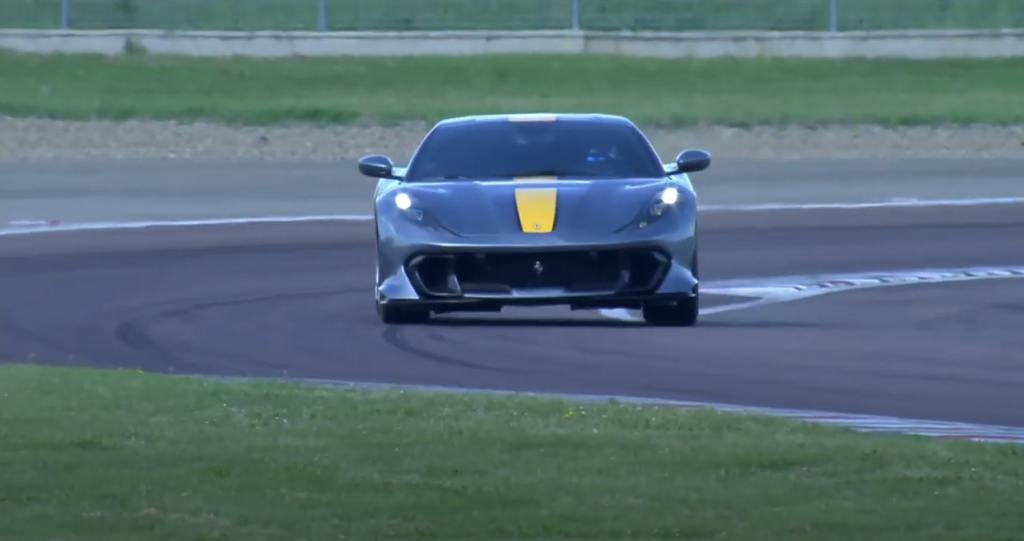
Die Tatsache, dass das Auto schneller in Kurven fährt, erforderte zudem eine Verbesserung der Bremskraft. Die Bremsenkühlung ist von grundlegender Bedeutung, um Kompromisse bei der Abtriebserzeugung an der Vorderseite des Fahrzeugs oder beim Gewicht der Bremsen selbst zu vermeiden. Im Vergleich zum 812 Superfast wurde das Konzept der Bremskühlung komplett um den neuen vorderen „Aero“ -Sattel herum überarbeitet, der schon beim SF90 Stradale vorgestellt wurde und in dessen Gussteil ein Lufteinlass integriert ist.
Die Belüftung der Bremssättel und der Bremsbeläge wird erreicht, indem die durch die großzügige Öffnung an der Seite des Stoßfängers aufgenommene kühle Luft zum integrierten Lufteinlass geleitet wird, der dann den Luftstrom innerhalb des Bauteils verteilt. Natürlich ist die Lösung nur so gut wie der Weg, dem der Durchfluss zum Bremssattelbereich an der Rückseite der Radbaugruppe folgt: Aus diesem Grund wurde die Vorderradaufhängung um die Nabe und die Anordnung der Rohre und Nebenaggregate in diesem Bereich optimiert.
Dank dieser Modifikationen hat sich die Temperatur des Bremsöls erheblich verringert: Im Vergleich zu den Bremsen des 812 Superfast wurden die Betriebstemperaturen um etwa 30 ° C gesenkt, wodurch ein gleichmäßiges Bremsen und ein gleichmäßiges Pedalgefühl auch bei längerer Lebensdauer gewährleistet werden kann, auch bei
Track-Nutzung. Durch das Entfernen der Drehflügel und des spezifischen Kanals des 812 Superfast konnten weitere 1,8 kg des Fahrzeuggewichts eingespart werden, wodurch das zusätzliche Gewicht des Bremssattels „Aero“ ausgeglichen wurde.

Zwei Carbon Lufteinlässe für die Bremsen flankieren den Hauptgrill, der dem Motor und dem Cockpit Kühlluft zuführt. Diese Einlässe haben einen quadratischen Querschnitt und sind zwischen Bremskühlung und in einen doppelten Luftschleierkanal aufgeteilt. Dank letzterem wird die geleitete Strömung, die auf die Seite des Stoßfängers trifft, kanalisiert und dazu verwendet, die durch den äußeren Teil des Reifenprofils erzeugten Turbulenzen zu verringern, wodurch der von der Außenkante der Stoßfänger erzeugte vordere Abtrieb verbessert wird.
Äußerlich werden die vorderen Lufteinlässe von dem geschöpften Seitenbereich des Stoßfängers umschlossen, der sich entlang seiner Unterkante nach vorne erstreckt und die Form des Verteilers definiert. Zwei Öffnungen im Radkasten, eine oben und eine hinten, reduzieren den Druck und ermöglichen es dem Unterboden, noch effizienter zu arbeiten. Die Turbulenzen werden durch die Entlüftungsrückseite des Motorhaubenblatts und durch die Flügel kanalisiert und abgeführt.
Die Optimierung der Wärmeflüsse war ein wesentlicher Bestandteil der Entwicklung des vorderen Unterbodens des 812 Competizione. Tatsächlich bedeuteten die Lamellen an der Motorhaube und die Lüftungsschlitze am Frontflügel, dass die Größe der Lüftungsschlitze im vorderen Unterboden, die die von den Kühlern austretende heiße Luft abführen sollen, verringert werden konnte. Dies führte dazu, dass ein kleinerer Bereich des Unterbodens von Öffnungen betroffen war, die sich negativ auf die Abtriebserzeugung auswirken würden. Das Endergebnis war ein höherer Abtrieb vorne und ein stärkerer Wind-Flow am Heck des Autos.
Die am Bremssystem vorgenommenen Änderungen ermöglichten es den Ingenieuren auch, den vorderen Unterboden neu zu gestalten, um ihn in den Radhausschacht zu verlängern. Das neue Layout, das Platz um den unteren vorderen Querlenker frei machte, ermöglichte es, die Oberfläche zu erweitern, die zur Erzeugung von Abtrieb verwendet werden können. Es ermöglichte auch das Einsetzen eines neuen S-förmigen Seitenwirbelgenerators, der speziell im Windkanal hergestellt wurde, um die seitliche Ausdehnung des erzeugten Wirbels zu verbessern und sicherzustellen, dass er in Synergie mit dem Frontdiffusor arbeitet. Die Geometrie des letzteren wurde ebenfalls optimiert und kann jetzt noch mehr Abtrieb als beim 812 Superfast erzeugen und die Kühlung des Bremssattels verbessern.
Zusammengenommen bedeuten diese Lösungen eine deutliche Verbesserung der Leistung: Die Optimierung der Lüftungsschlitze trägt zu einer 30-prozentigen Steigerung des gesamten vorderen Abtriebs bei, während der neue Seitenwirbelgenerator weitere 40 Prozent hinzufügt.
Wie beim 812 Superfast ist der Frontdiffusor mit einem passiven mobilen Aero-System ausgestattet, das über 250 km / h öffnet. Wenn sich die Verkleidung dreht, wird der Diffusor vollständig blockiert, sodass das Fahrzeug seine Höchstgeschwindigkeit erreichen kann.
Die unverwechselbare Heckkonfiguration des 812 Competizione umfasst eine Reihe innovativer technischer Lösungen hinsichtlich Auspuffanordnung, Diffusorgeometrie, Spoilervolumen, patentierter Heckscheibe und Stoßstangendesign. Der Heckdiffusor erstreckt sich über die gesamte Breite des Fahrzeugs, um eine maximale horizontale Ausdehnung der aerodynamischen Strömungen des Unterbodens zu gewährleisten, und führt zu einer deutlichen Veränderung zur der des 812 Superfast.
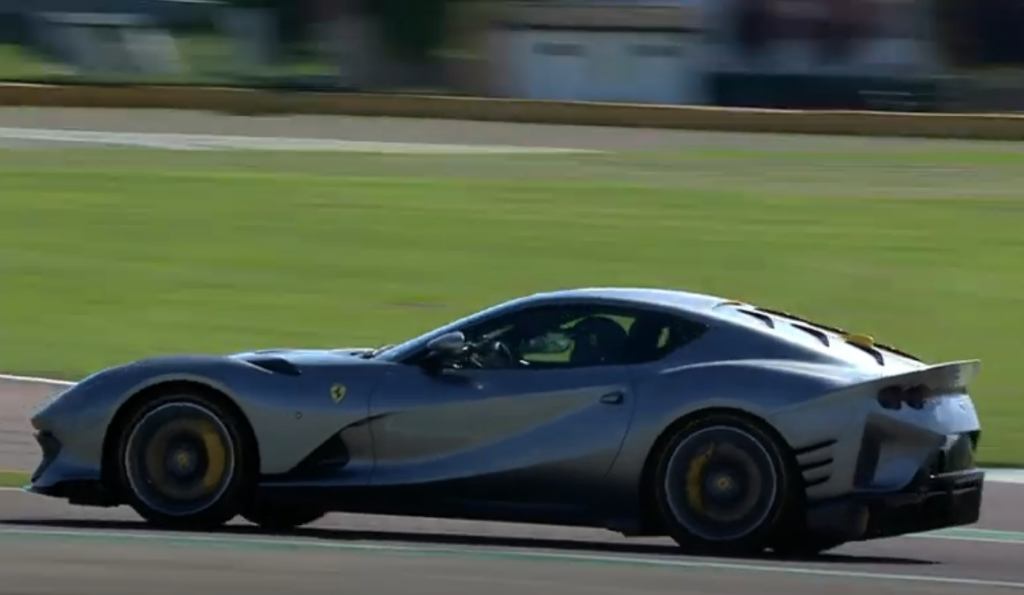
Die drei horizontalen Schlitze an der Seite der hinteren Stoßstange direkt hinter dem Hinterrad sind eine weitere optisch auffällige Neuheit. Sie erinnern nicht nur an den F12tdf, sondern verbergen auch ein System aus drei aerodynamischen Flicks. Aufgrund des Niederdruckbereichs, der durch das Nachlaufen des Fahrzeugs entsteht, wird ein Teil der Strömung stromabwärts des Hinterrads naturgemäß in Richtung Fahrzeugmitte gezogen. Bei dieser neuen Lösung tritt sie jedoch durch die drei horizontalen Schlitze in den Stoßfänger ein und wird dann von den internen Flicks nach oben abgelenkt, was zum hinteren Abtrieb beiträgt.
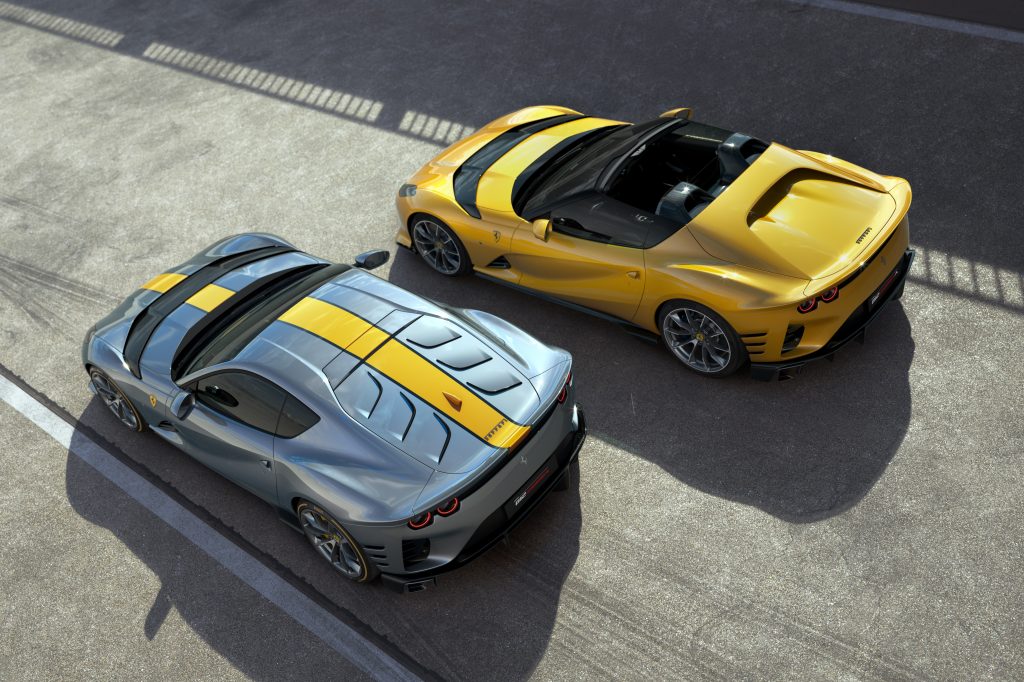
Im 812 Competizione Aperta wurde ein Brückenelement zwischen den Strebenpfeilern eingeführt, um die Auswirkungen der Entfernung der Wirbelgeneratoren auszugleichen. Dank sorgfältiger Optimierung wird der Durchfluss effektiv und effizient in Richtung Heckspoiler abgelenkt, wodurch der Abtrieb im Wesentlichen auf dem Niveau des 812 Competizione wiederhergestellt wird. Durch das Vorhandensein der Brücke konnte der physiologische Widerstand eines Wagens vom Typ Targa verringert werden: Aerodynamisch verhält sich die Brücke wie ein Flügel, sodass der Druck auf der Oberseite ein Überdruckfeld erzeugt, das die Strömungsgeschwindigkeit zur Heckscheibe des Autos hin erhöht und den Luftwiderstand reduziert.
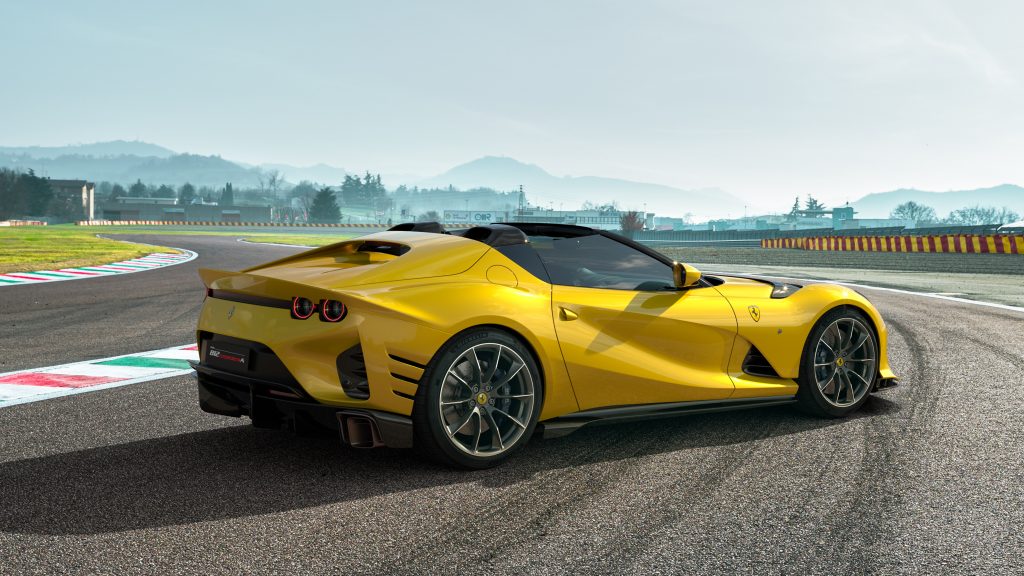
Der Insassenkomfort in der offenen Konfiguration wird durch die Einführung einer in die Kopfleiste der Windschutzscheibe integrierten Klappe gewährleistet, die den einfallenden Wind nach oben ablenkt und verhindert, dass erim Innenraum Verwirbelungen erzeugt. Dadurch wird eine Art Blase über die gesamte Länge des Cockpits verlängert, wodurch auch ein störender Überdruck im Bereich hinter den Köpfen der Insassen vermieden wird.
Zwischen den beiden Strebepfeilern wurden zwei aerodynamische Öffnungen geschaffen, um die über die Seitenfenster eintretende Strömung zu steuern und sie zu zwingen, einer bestimmten Route zu folgen. Dies ist ein grundlegender Faktor, um sowohl den Druck in der Kabine als auch die Instabilität der Strömung selbst zu verringern. Diese Strategie hat zwei Ergebnisse, da sie nicht nur den Komfort verbessert, sondern auch die aerodynamische Effizienz erhöht wird indem sie den Durchfluss auch bei geöffnetem Verdeck stabilisiert.
Last but not least wurden also viele Details geändert, wobei für manche vielleicht das Wichtigste die Abgasanlage darstellt, die mit ihrem neuen Konzept des Luftstroms auch neue Partikelfilter verwendet, die aber auch den typischen Ferrari-Sound bewahrt und sogar optimiert haben, sicher sehr geschätzt auf allen berühmten Boulevards von Ferraristi auf der ganzen Welt.
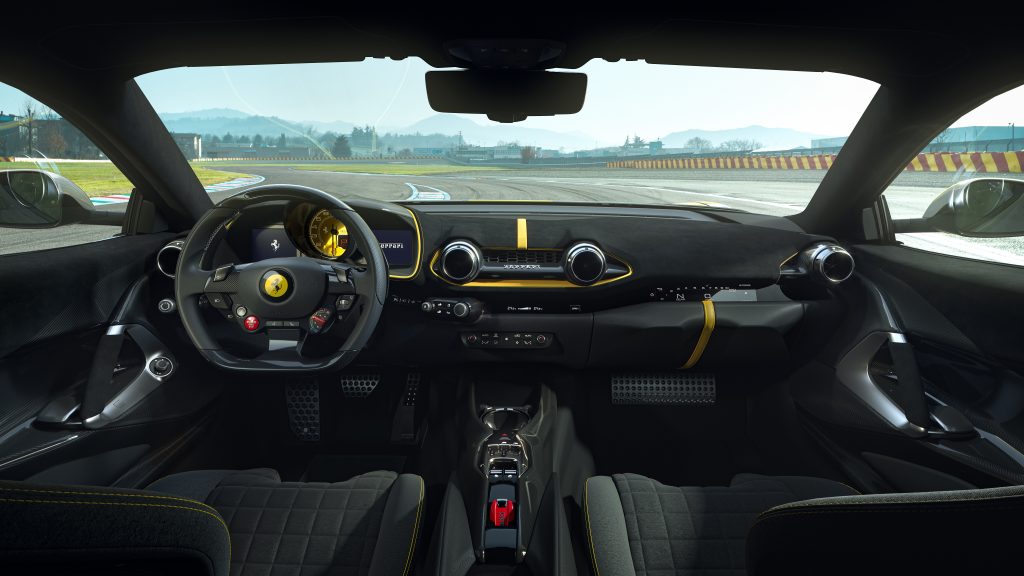
Das am Mitteltunnel platzierte Schaltdisplay ist nun als Hommage gleich den offenen Schaltgassen, dem Open-Gate Schema der handgeschalteten Ferrari des letzten Milleniums gestaltet.Die Fortführung der Legende geschieht also nicht, indem man die Asche anbetet, sondern sie mit innovativen Adaptionen am Glimmen hält. Die Legende lebt weiter.
812 COMPETIZIONE TECHNISCHE SPEZIFIKATIONEN
MOTOR TypV12 -65°
Gesamthubhaum6496 cm3 Bohrung und Hub94 mm x 78 mmMax. Ausgangsleistung**830 PS (610kW) bei 9.250 U/min Max. Drehmoment**692Nm bei7.000 U/minMax. Motordrehzahl9.500 rpm Verdichtung13,5:1
ABMESSUNGEN UND GEWICHT
Länge4.696mm Breite1.971 mm Höhe1.276mm Radstand2.720 mm Spurweite vorne 1.672 mm Spurweise hinten 1.645 mm Trockengewicht ***1.487kg Leistungsgewicht1,79kg/PS Gewichtsverteilung49% vorne–51% hintenTankvolumen92 l
REIFEN UND FELGEN
Vorne275/35 ZR20; 10” J x 20” Hinten315/35 ZR20; 11,5” J x 20” BREMSEN Vorne398 mm x 223 x 38 mm Hinten360 mm x 233 x 32 mm
KRAFTÜBERTRAGUNG/GETRIEBE 7-Gang-F1-Doppelkupplungsgetriebe ELEKTRONIKPCV 3.0 (Passo Corto Virtuale–virtueller kurzer Radstand) mit unabhängiger4-Rad-Lenkung; ESC; Hochleistungs-ABS/EBD; F1-Trac; E-Diff3; SCM-Emit 2 Spulen; SSC (Side Slip Control) 7.0
FAHRLEISTUNGEN
Max. Geschwindigkeit>340 km/h 0-100 km/h2,85 Sek. 0-200 km/h 7,5Sek.
Fiorano Rundenzeit 1’20“
Ferrari 812 Competizione
Sold out. 999 units of the today presented Ferrari 812 Competizione Coupe and 599 of its Spider version Aperta will be produced. But are already absorbed by the Ferrari clients, who ordered their cars in advance, maybe they were keen to posess one of the last normally aspirated V12 Ferrari, which is not confirmed by Ferrari. We´ll see.

The presentation took place in a very special venue, the recently-opened GT Sporting Activities Department located alongside the Fiorano track, further strengthening the inextricable link between Maranello’s road-going sports cars and the racing DNA emerged as a result of over seven decades of successfull motorsport on the world’s circuits.
The launch began with the 812 Competizione completing several laps of the circuit to give viewers a full appreciation of the car’s forms in this dynamic and high performance context in addition,and of course, to hear the unmistakeable sound of Ferrari’s iconic naturally-aspirated V12. After the hot laps Enrico Galliera, Ferrari’s Chief Marketing & Commercial Officer, officially presented the car and then unveiled the 812 Competizione A.
830 hp as output thanks to the redesign of many key components of the engine, a new valve control, and a new exhaust system raise the performance of the V 12, and bring up the rev limit to 9.500 rpm/min. Revised driving dynamics control systems, including the Side Slip Control (SSC) version 7.0 and rear-wheel steering, first time independently by different angels of the wheels, deliver a feeling to the driver, as if the Competizione is leaning on the outside tires and increase agility and driving dynamics.
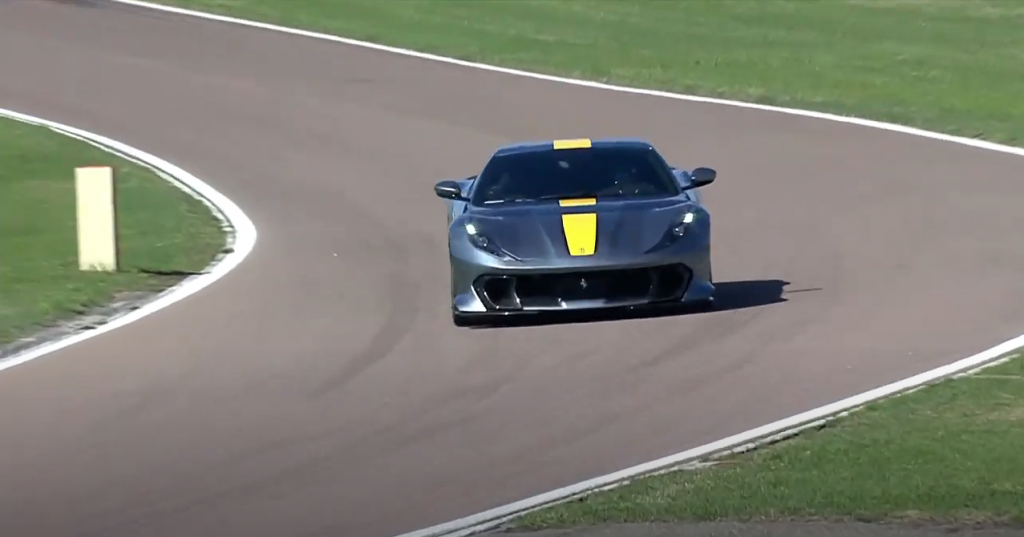
In detail the 812 Competizione debuts many innovative components and contents, which have ensured it delivers on its vehicle dynamics performance targets. Specifically, these include the first use of independent four-wheel steering, the evolution of the Side Slip Control (SSC) system to version 7.0, and the development of the dedicated new Michelin Cup2R tyres.
The independent rear-wheel steering features a new electronic management system that enables the right and left actuators to be actioned individually rather than synchronised. This evolution yields a significant boost in performance in relation to the control of the position demanded of the individual actuators, and quicker response times.
This system emphasises the front axle’s response to steering wheel commands, maintaining the feeling of grip from the rear axle, which responds promptly to front inputs, and also manages the car’s lateral dynamics response more efficiently as a function of the actuation frequency of the steering wheel angle.
The new solution has resulted in the evolution of the SSC system which brings together all of the control systems developed in-house and uses a shared dynamic control language to integrate the actions of all of the systems to improve efficiency. The Side Slip Control 7.0 spans the electronic differential (E-Diff 3.0), traction control (F1-Trac), SCM-Frs magnetorheological suspension control, brake pressure control when driving on the limit (FDE) available in Race and CT-Off Manettino settings, and the Virtual Short Wheelbase 3.0 which integrates the electric front steering with the electronically controlled independent rear-wheel steering.
As ever the devil is in the details
With the increased use of carbon components in the bodywork and in the interior, the total weight of the new Ferrari bolide was reduced by 38 kilos. Aerodynamic changes in the body, especially the replacement of the glass rear window of the 812 superfast by an aluminum cover, which additionally optimizes the aerodynamics with so-called Vortex generators derrivated from the racing departement. So the 812 Competizione produces 80 kilos more downforce at 200 kph as the 812 Superfast.
Aerodynamics and cooling flow management
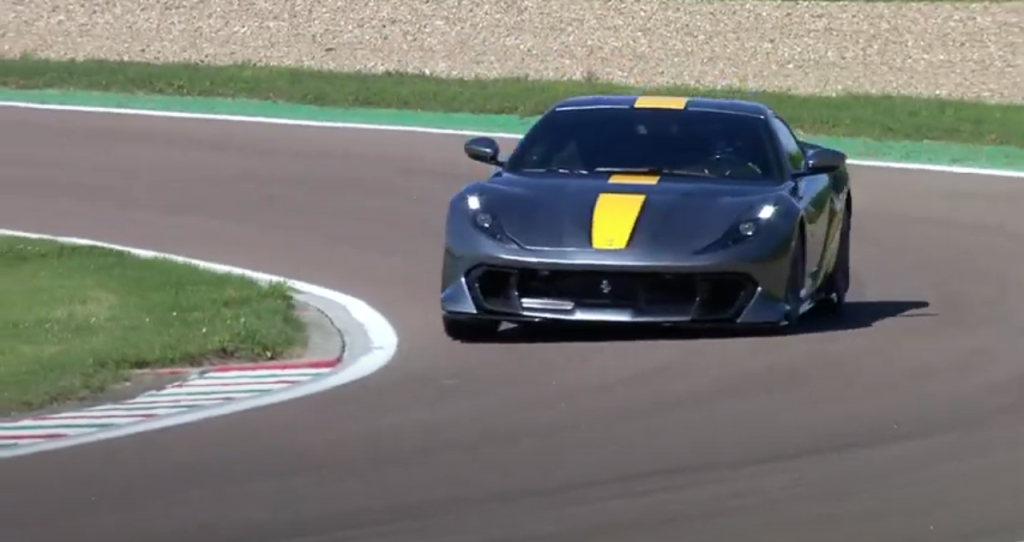
The increase in both the 812 Competizione’s engine output and maximum revs have resulted in a consequent increase in the heat to be dissipated. To meet these new demands, the efficiency of the cooling flow management has been improved without increasing the dimensions and weight of the radiating masses.
While on the 812 Superfast, the engine air intakes are set either side of the large central grille, the 812 Competizione adopts an integrated solution with a single air duct. This allowed the intake for the engine radiators to be extended sideways as far as the chassis allowed as well as reducing not just weight, but also losses to the intake plenum and thus the combustion chamber, which in turn, improved the overall performance.
The evacuation of the hot air coming off the radiator was improved by exploiting both the vents on the bonnet either side of the central ‘blade’, and the louvers in the wings. These areas are particularly efficient in terms of cooling and so allowed the designers to optimise and reduce the apertures on the underbody, all to the benefit of the efficiency of the front aero. All of this translates into 10 percent more efficient cooling of the engine fluids than in the 812 Superfast.

The shape of the engine vents either side of the bonnet’s blade is designed to guarantee correct management of the flows even when the 812 Competizione A is being driven in the open configuration: the hot air flow lines are deviated away from the cockpit and are channelled along the flanks until they eventually merge with the car’s wake.
The fact that the car is faster into corners demanded an improvement in braking power. Brake cooling is fundamental to avoiding compromising on either downforce generation at the front of the car or on the weight of the brakes themselves. Compared to the 812 Superfast, the brake cooling concept was completely redesigned around the new front “Aero” calliper which debuted on the SF90 Stradale and which has an air intake integrated into its casting.
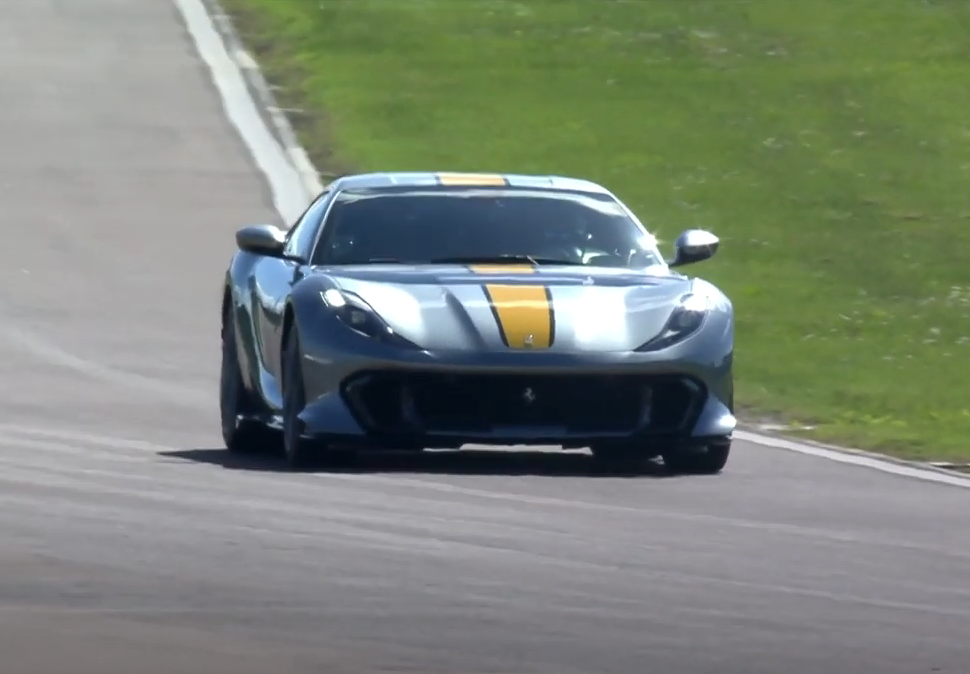
Ventilation of the callipers and the pads is achieved by channelling the cool air captured by the generous opening on the side of the bumper towards the integrated air intake which then distributes the air flow inside the component. Naturally, the solution is only as good as the route the flow follows to get to the calliper area at the rear of the wheel assembly: for this reason the front suspension was optimised around the hub and the layout of pipes and ancillaries in that area.
Thanks to these modifications, the temperature of the brake oil has seen a significant reduction: compared to the brakes on the 812 Superfast, operating temperatures have been reduced by around 30° C, thus guaranteeing consistent braking and equally consistent pedal feel even under prolongedtrack use. The removal of the 812 Superfast’s turning vanes and specific duct shaved a further 1.8 kg off the car’s weight, thus compensating for the additional weight of the “Aero” calliper.
Two carbon-fibre side air intakes for the brakes flank the main grille, which feeds cooling air to the engine and cockpit. These intakes are square in section and are split between brake cooling and a double air curtain duct. Thanks to the latter, the charged flow that strikes the side of the bumper is channelled and used to reduce the turbulence generated by the outer part of the tyre tread, thereby improving the front downforce generated by the outside edge of the bumpers.
Externally the front air intakes are hugged by the scooped side area of the bumper, which extends forwards along its lower edge, defining the shape of the splitter. Two apertures in the wheelarch, one at the top and one at the rear, reduce pressure and enable the underbody to work even more efficiently. The turbulence is channelled and evacuated by the vent rear of the bonnet’s blade, and by that on the wing.

Optimising thermal flows was a fundamental part of developing the 812 Competizione’s front underbody. In fact, the louvres on the bonnet and vents on the front wing meant the size of the vents in the front underbody designed to dissipate hot air coming off the radiators, could be reduced. This translated into a smaller area of the underbody being affected by apertures that would negatively impact downforce generation. The end result was a higher level of downforce at the front and a more energised flow striking the rear of the car.
The modifications made to the braking system also enabled the engineers to redesign the front underbody to extend it into the wheelarch well. The new layout, which freed up space around the lower front wishbone, made it possible to extend the surface area that could be used to generate downforce. It also allowed the insertion of a new S-shaped side vortex generator crafted specifically in the wind tunnel to improve the lateral expansion of the vortex generated and ensure it works in synergy with the front diffuser. The geometry of the latter was also optimised and can now generate even more downforce than the 812 Superfast as well as improving cooling of the calliper. Taken together these solutions hail a significant improvement in performance: optimising the air vents contributes to a 30 percent increase in overall front downforce while the new side vortex generator adds a further 40 percent.
Like on the 812 Superfast, the front diffuser is equipped with a passive mobile aero system which opens over 250 km/h. When the panel rotates it completely stalls the diffuser allowing the car to reach its maximum speed.
The 812 Competizione’s distinctive tail-end treatment incorporates a number of innovative engineering solutions regarding the exhaust layout, diffuser geometry, spoiler volume, patented rear screen and the bumper design. The rear diffuser extends right across the full width of the car to guarantee maximum horizontal expansion of the underbody’s aerodynamic flows and hails a distinct break with the solution seen on the 812 Superfast.

The silencers and tailpipes have been completely re-engineered: from a classic set up of two circular tailpipes each side of the bumper there is now a single exhaust pipe with an unprecedented vertical rectangular form. This had two positive impacts: it maximised the volume dedicated to the rear diffuser’s expansion and opened up the possibility of introducing a solution typical of F1 cars from the 2010s to a road car – dynamic interaction between the exhaust gases and the diffuser’s field. In this configuration, the hot flow of gas from the exhaust pipes interacts with the prominent curved exterior fences on the diffuser, generating extra vorticity at the trailing edge of the fences, which energises the “cold” flow from the diffuser thereby guaranteeing additional downforce.
Overall, the rear diffuser development produced an increase in downforce that equates to 25 percent of the total increase compared to the 812 Superfast. This jumps to 35 percent if the contribution of the exhausts blowing into the wake is also taken into account. The rear underbody, on the other hand, is responsible for a 10 percent increase in rear downforce.
The aerodynamic development of the diffuser forms allowed the areas of the car dedicated to downforce generation to be extended transversely. The spoiler is now not only higher than on the 812 Superfast, but extends across almost the entire width of the car, working in perfect aerodynamic synergy with the diffuser to guarantee maximum downforce possible over the rear axle. The redesign of the rear wings also benefits aerodynamic performance: the volume has been scooped out rear of the crest to create an aerodynamic channel in the flank to the outside edge of the spoiler which is thus struck by a highly energised flow.
But what really captures the attention is the rear screen which, for the first time on a production car, is completely closed and thus allowed the engineers to explore some unprecedented aerodynamic solutions. It has been equipped with three pairs of profiled elements which protrude from its surface and act as vortex generators. From the La Ferrari onwards, vortex generators of this type have been used on production cars to maximise downforce generated by the flat underbody. However, this solution was applied to the rear screen on the 812 Competizione to distort the flow and thus redistribute the rear axle’s pressure field.
These vortex generators further enhance the work of the rear spoiler-diffuser system, creating areas of strong pressure gradients in the flow immediately above the rear screen and generating vortexes on the transverse plane. Thanks to this solution, part of the flow is deflected towards the sides of the spoiler which boosts downforce generation, benefiting the efficiency of the diffuser. The patented vortex generators alone guarantee 10 percent of the total increase in rear downforce compared to the 812 Superfast.
The three horizontal slots on the side of the rear bumper just behind the rear wheel are another visually striking novelty. In addition to recalling the F12tdf, they also hide a system of three aerodynamic flicks. Due to the low-pressure area created by the car’s wake, part of the flow downstream of the rear wheel naturally tends to be drawn towards the centre of the car. However, with this new solution, it enters the bumper through the three horizontal slots and is then deflected upwards by the internal flicks, contributing to rear downforce.
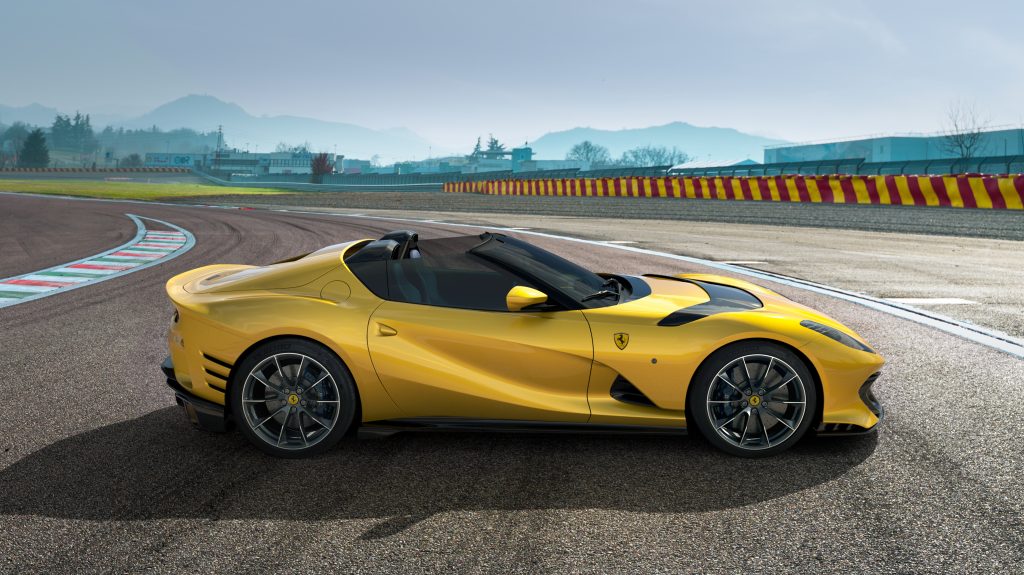
In the 812 Competizione Aperta, to compensate for the impact of the removal of the vortex generators, a bridge element has been introduced between the flying buttresses. Thanks to meticulous optimisation, the flow is deflected effectively and efficiently towards the rear spoiler, essentially restoring the downforce to the same level as the 812 Competizione. The presence of the bridge allowed the increase in physiological drag for a Targa type car to be reduced: aerodynamically, the bridge behaves like a wing so the pressure on the upper surface creates a positive pressure field which increases the speed of the flow downstream of the rear screen and reduces drag.
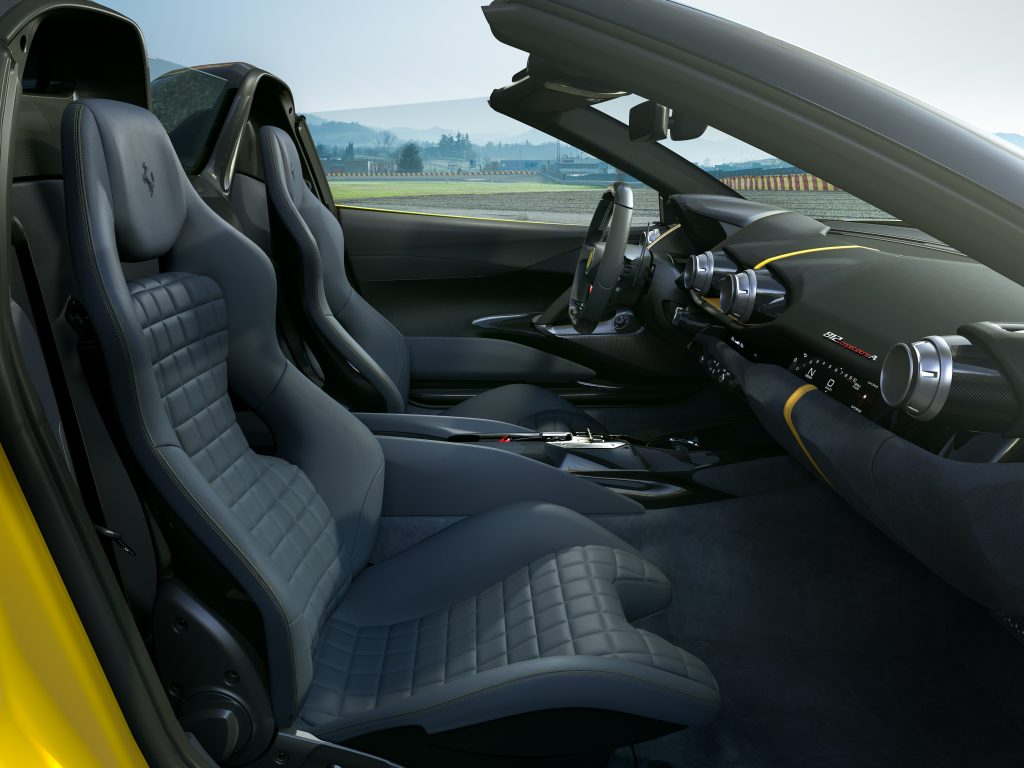
Occupant comfort in the open configuration is ensured by the introduction of a flap integrated into the windscreen header rail which deflects the energised, incident flow upwards avoiding that it disturbs the interior. This extends the bubble that covers the entire length of the cockpit, thereby also avoiding irritating excess pressure in the area behind the occupants’ heads.
Two aerodynamic apertures have been created between the two buttresses to manage the flow entering over the side windows and to force it to follow a specific route, a fundamental factor in reducing both pressure inside the cabin and the instability of the flow itself. The result of this strategy is twofold because, aside from improving comfort, it also increases aerodynamic efficiency by making the flow stable even when the top is open.
Last but not least and to sum it up a lot of details have been changed, like the exhaust system, which with its new concept of air flow and particle filters to match emission regulations worldwide, also preserves and even optimizes the typical Ferrari sound, which will be highly appreciated on all famous boulevards by Ferraristi the world over.

Details rule. So is the gear switch display placed on the middle tunnel, now also a reminecence to the open gate scheme of the Ferraris of the last millenium. The Legend lives on.
812 competizione* – TECHNICAL SPECIFICATIONS
ENGINE
Type V12 – 65°
Overall displacement 6496 cc
Bore and stroke 94 mm x 78 mm
Max. power output** 610 kW (830 cv) at 9,250 rpm
Max. torque** 692 Nm at 7,000 rpm
Max. engine speed 9,500 rpm
Compression ratio 13.5:1
DIMENSIONS AND WEIGHTS
Length 4,696 mm
Width 1,971 mm
Height 1,276 mm
Wheelbase 2,720 mm
Front track 1,672 mm
Rear track 1,645 mm
Dry weight*** 1,487 kg
Dry weight/power 1.79 kg/cv
Weight distribution 49% front – 51% rear
Fuel tank capacity 92 l
WHEELS & TYRES
Front 275/35 ZR20; 10” J x 20”
Rear 315/35 ZR20; 11.5” J x 20”
BRAKES
Front 398 mm x 223 x 38 mm
Rear 360 mm x 233 x 32 mm
TRANSMISSION AND GEARBOX
7-speed F1 DCT
ELECTRONIC CONTROLS
PCV 3.0 (Passo Corto Virtuale – Virtual Short Wheelbase) with 4-wheel independent steering; ESC;high-performance ABS/EBD; F1-Trac; E-Diff3; dual-coil SCM-E; SSC (Side Slip Control) 7.0
PERFORMANCE
Max. speed > 340 km/h
0-100 km/h 2.85 sec
0-200 km/h 7.5 sec
Fiorano lap time 1’ 20”
-Ends-
images and videos Ferrari S.p.A copy beyondcoolmag
